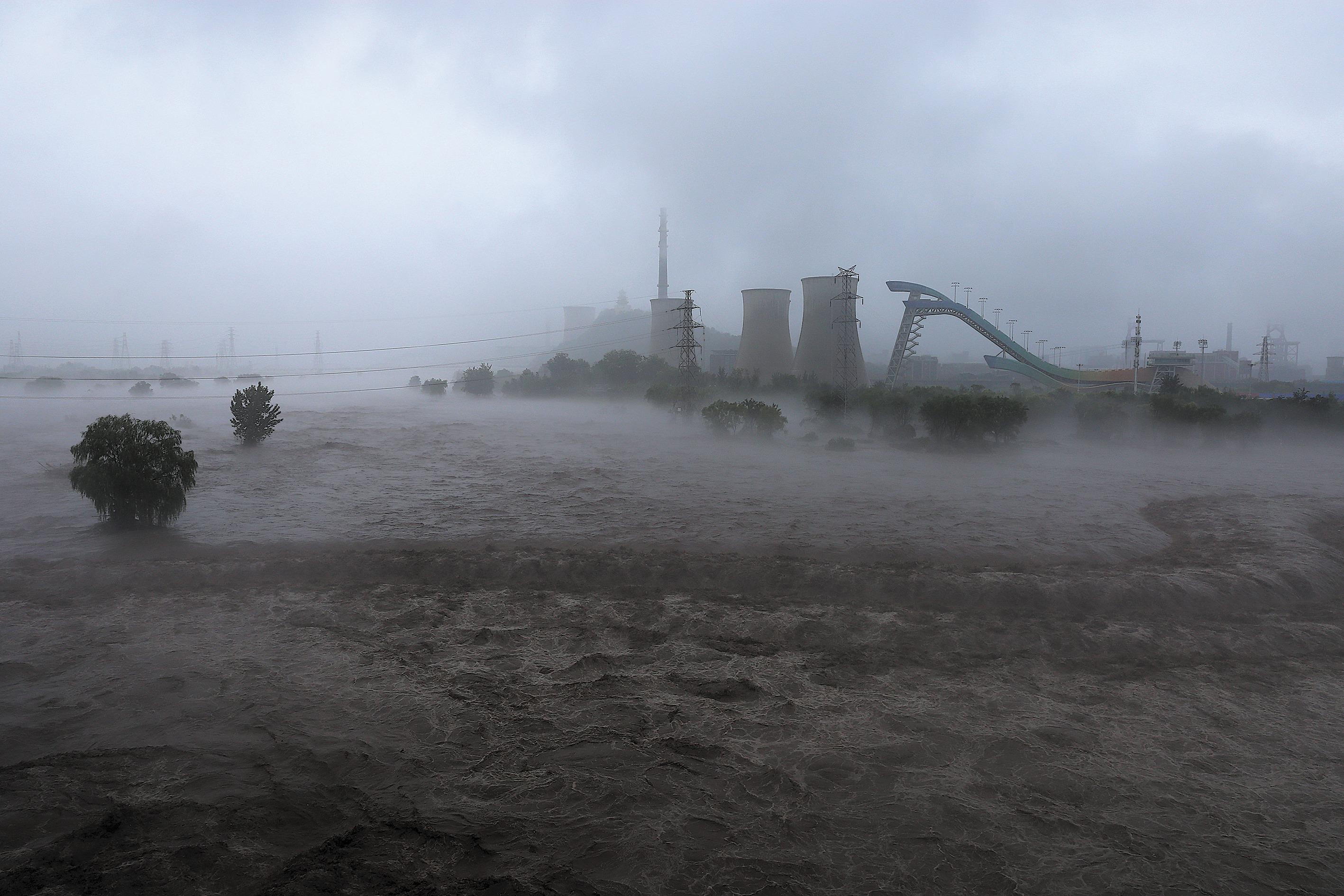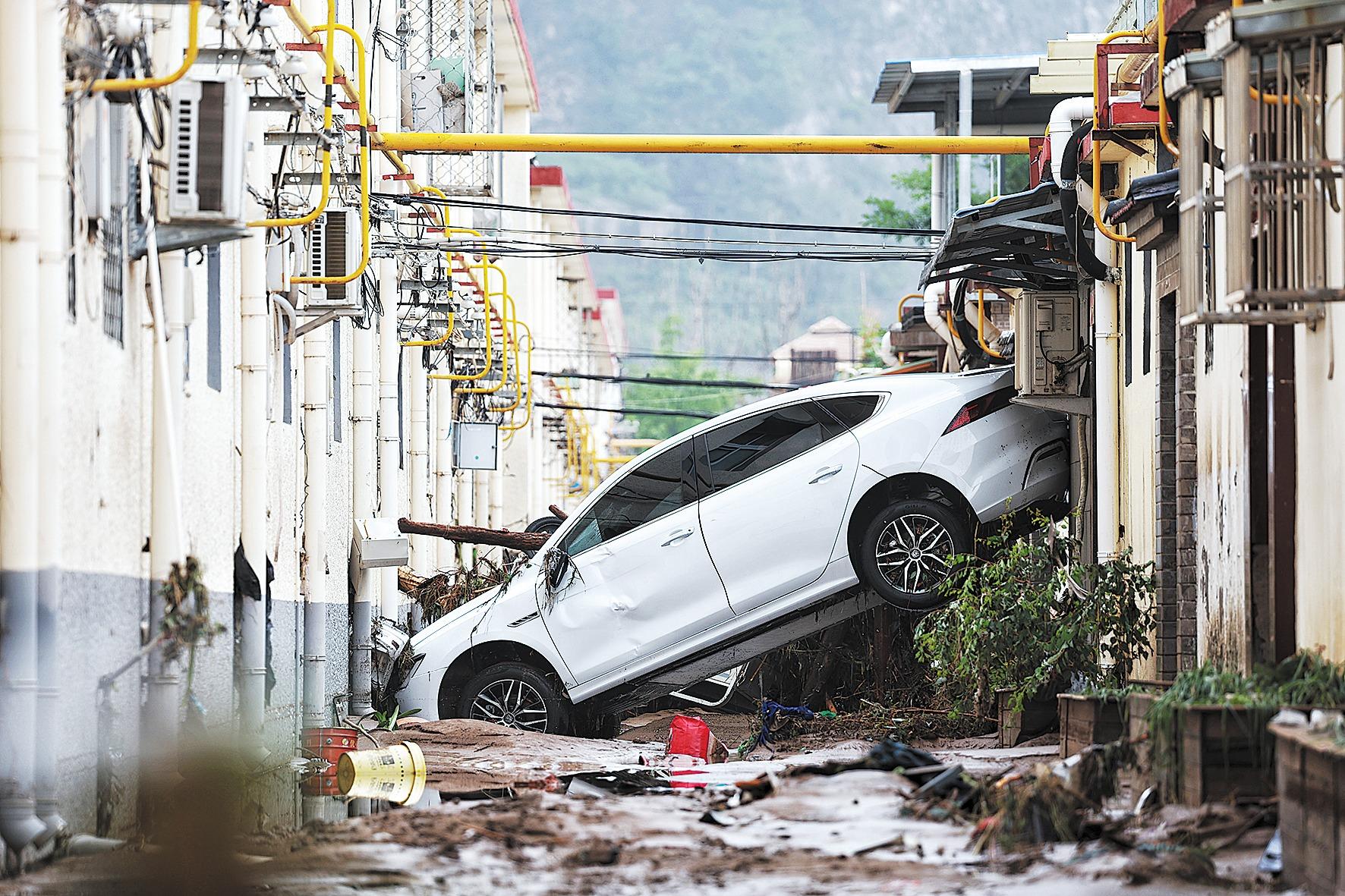Sponge cities, upgrades to infrastructure important to mitigate climate change impact
 A view of the Yongding River in western Beijing on Aug 1 taken from the New Shougang Bridge, with a venue for the 2022 Winter Olympics in the background. (WU XIAOHUI / CHINA DAILY)
A view of the Yongding River in western Beijing on Aug 1 taken from the New Shougang Bridge, with a venue for the 2022 Winter Olympics in the background. (WU XIAOHUI / CHINA DAILY)
Torrential rainfall and subsequent flooding in the Beijing-Tianjin-Hebei region have focused renewed attention on China’s determination to strengthen protection against natural disasters.
By implementing the sponge city concept and comprehensive upgrades to infrastructure, the nation is striving to mitigate the impact of heavy rainfall and safeguard people’s well-being.
The sponge city initiative, launched to adapt to climate change, aims to reduce urban flooding by constructing facilities that help absorb and capture rainwater for future use.
Under the influence of Typhoon Doksuri, heavy rain began to engulf the region on July 29.
Zhu Dingzhen, former chief officer at the China Meteorological Administration’s Public Meteorological Service Center, said, “Many regions in China still rely on infrastructure that adheres to outdated disaster defense standards.”
“If the climate keeps changing at the current rate, losses from such disasters will be considerably higher than in previous decades, due to current population numbers and the scale of economic development,” Zhu said.
Some regions still rely on outdated infrastructure, which may not withstand the impact of climate change, especially in traditionally dry areas that are experiencing increased rainfall that threatens to overwhelm these regions, Zhu said.
“It is crucial for China to plan and upgrade its infrastructure to adapt to future changes, as the nation faces a wide range of natural disasters due to its diverse climate and geographical features,” he added.
For example, northwestern regions could face the prospect of roads being washed away and river channels collapsing from as little as 20 millimeters of rainfall. The increased rainfall could saturate soil on the Loess Plateau, where many villages are situated on loess soil, and there is a heightened risk of secondary disasters, Zhu added.
The recent heavy rainfall in the Beijing-Tianjin-Hebei region was labeled a “historically extreme event” by the National Meteorological Center.
 Residents view an area damaged by floods in Zhoukou town, Fangshan district, Beijing.
(FENG YONGBIN / CHINA DAILY)
Residents view an area damaged by floods in Zhoukou town, Fangshan district, Beijing.
(FENG YONGBIN / CHINA DAILY)
The downpours surpassed others of a serious nature that occurred in the region in 1996, 2012 and 2016, with the center saying that it rained continuously for 83 hours in Beijing from July 29 to Aug 1.
During this period, the accumulated rainfall was double or even triple the average for the time of year. In one village — Liangjiazhuang in Xingtai, Hebei — rainfall over two days exceeded 1.3 meters, more than twice the average annual precipitation for the area, the center said.
Beijing’s weather service said rainfall of 744.8 mm was recorded at Wangjiayuan Reservoir in the capital’s Changping district during this period, the largest amount recorded in the city for 140 years.
From 8 am on July 29 to 5 pm on Aug 1, the volume of rainfall in Beijing reached about 4.3 billion cubic meters, Beijing News reported.
At a news conference on Aug 9, Xia Linmao, executive vice-mayor of Beijing, said that 33 people, including five rescuers, died in the recent flooding, while 18 people, including a rescuer, remain missing as of Aug 8. “We extend our sincerest condolences to their families,” Xia said. A moment of silence was observed during the news conference to honor the deceased.
Nearly 1.29 million people were affected and widespread economic losses were reported, especially in western Beijing’s mountainous Fangshan and Mentougou districts.
A total of 369 geological disasters were reported, which was 10.5 times higher than the annual average, according to the municipal government. Flooding led to the collapse of 59,000 houses and severely damaged another 147,000. Floodwaters also inundated over 15,000 hectares of farmland.
The capital has outlined a post-disaster reconstruction plan, aiming to achieve basic recovery in one year and comprehensive improvement in its response capacity in three years as well as long-term sustainable development.
In the basic recovery phase, water management facilities and damaged houses will be repaired and reinforced in urban and rural areas within a year, Xia said. Post-disaster recovery and reconstruction work will be fully completed in three years with improvement in disaster prevention and reduction capacities, he said.
Zhang Chi, professor of management and economics at the Beijing Institute of Technology, said extreme weather conditions caused by climate change continue to pose significant threats to vulnerable populations, and adaptation measures are urgently needed.
 A vehicle is stuck in a flooded area of Miaofengshan town, Mentougou district, Beijing. (TAO RAN / FOR CHINA DAILY)
A vehicle is stuck in a flooded area of Miaofengshan town, Mentougou district, Beijing. (TAO RAN / FOR CHINA DAILY)
The 2022 China report of the Lancet Countdown on health and climate change: leveraging climate actions for healthy aging, said that from 2016 to 2020, the average exposure to extreme rainfall and drought per person increased by 71.6 percent.
Zhang, one of the report’s first authors, said, “Vulnerable groups are suffering more from climate change. For example, older people are at greater risk than young people from such extreme weather, but they are less willing to move home.”
“The recent flooding not only devastated farmers’ crops but also harmed their health. Without immediate support and adaptation strategies to mitigate the impact, this already vulnerable group faces a vicious cycle of adversity,” she said.
The devastating impact of recent torrential rain has again highlighted the importance of China’s ongoing efforts to strengthen its defenses against natural disasters.
The nation aims to build sponge cities to mitigate the impact of torrential rain. Such cities absorb, store, filter and purify rainwater. When needed, they release and use stored water.
In 2014, the Ministry of Housing and Urban-Rural Development issued the Pilot Technical Guidelines for Sponge City Construction, designating Beijing among the pilot cities for this concept.
The guidelines aim to create cities with the ability to adapt to environmental changes and effectively respond to natural disasters, functioning in a way similar to sponges.
Government departments, including urban planning, drainage, transportation and landscaping, are involved in guiding the process.
The guideline states that to build such cities, efforts should be made to prevent urban areas sprawling rapidly, and adequate areas of green space, along with footpaths made from permeable materials should be provided.
Other efforts should include connecting water systems such as rivers, lakes, wetlands, ponds and canals with urban rainwater pipe networks and excess rainwater discharge systems, the guideline states.
The ministry said that over the years problems have arisen, with some cities misunderstanding sponge city construction. These problems could hamper efforts to bolster resilience against disasters, according to a statement released by the ministry last year.
There are problems in building water filtration systems regardless of geological conditions, drawing drainage zoning boundaries based solely on administrative divisions, and adding drainage hurriedly after the completion of design plans for buildings, roads and gardens.
She Nian, head of the Smart Sponge City Planning and Construction Research Institute at the Tsinghua Innovation Center in Zhuhai, Guangdong province, told Southern Weekly on Aug 2 that the carrying capacity of northern sponge cities is lower than that of southern cities.
“Northern cities need to improve awareness of how sponge cities tackle urban flooding, as, in the past, northern regions have not experienced frequent rainfall or heavy storms like southern areas,” She said.
During construction of sponge cities, attention should be paid to building green belts, rather than relying solely on traditional rainwater drainage systems, he was quoted as saying.
In 2021, the UN Office for Project Services, the UN Environment Programme and the University of Oxford co-published a report titled Infrastructure for Climate Action.
The report emphasizes the importance of treating infrastructure as a key area for addressing climate change — urging governments to reassess how to deliver and manage infrastructure to ensure it is suitable for a resilient future.
In recent years, cities worldwide have sought ways to enhance their resilience to climate change. However, implementing such measures often comes at a high financial cost.
One example is the case of New Orleans in the United States, and the city’s suburbs located south of Lake Pontchartrain.
Following the destructive Hurricane Katrina in 2005, the federal government invested $14.5 billion on installing levees, pumps, seawalls, floodgates and drainage systems to carry a massive amount of water away from houses and into wetlands.
This infrastructure has since protected the area from damage caused by storms, the Associated Press reported in 2021.


